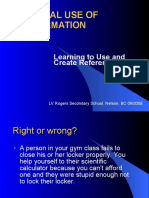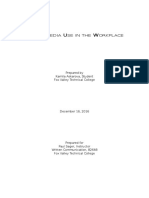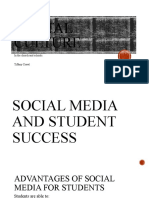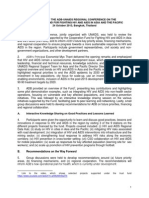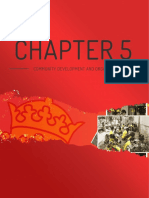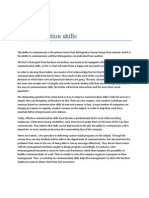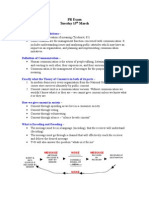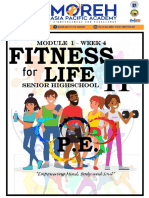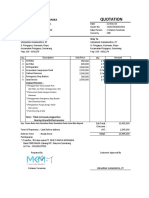Uts Module 7
Uts Module 7
Uploaded by
Dela Rama Virgilio StephenCopyright:
Available Formats
Uts Module 7
Uts Module 7
Uploaded by
Dela Rama Virgilio StephenOriginal Title
Copyright
Available Formats
Share this document
Did you find this document useful?
Is this content inappropriate?
Copyright:
Available Formats
Uts Module 7
Uts Module 7
Uploaded by
Dela Rama Virgilio StephenCopyright:
Available Formats
GENERAL EDUCATION 1- UNDERSTANDING THE SELF DARRELL P.
LOMEDA, Instructor
MODULE 7- THE SOCIO- DIGITAL SELF
Intended learning outcomes
At the end of this section, you are expected to:
1. Discuss and elaborate the different concepts of the socio- digital self.
2. Identify factors that influence one’s online behaviors.
This section examines the role of technology and the internet in shaping an individual’s social self,
with the emphasis on the use of social media platforms and membership in virtual communities.
This section highlights the crucial role of the internet in forming the self and identity of millennial
learners.
The Self in the Age of Technology
With the rise of technology, ways of socializing have significantly changed. In the past, interpersonal relationships
can only be established through face-to-face interactions within physical communities. Nowadays, people can
interact with each other even if they are not physically present in the same place.
Social Media is defined as the websites and applications that make it easier to create and share information, ideas
and interests. Social media has features that allow people to communicate to specific groups sharing common
interests and become members of virtual communities, be it local or globally. Through the use of social media,
people may act differently since interaction in social media do not happen face to face and no physical presence
required. This is called online disembodiment. With this, people are less likely to display their real “selves” to others,
especially to strangers.
Digital Identity
People generally have “role identities.” These are the characters and roles of an individual creates as a member of a
particular social group. In an online environment, one’s role identity is vitally important in order for him or her to
project herself or himself in the said environment. Amidst the technological tools and channels surrounding
individuals and online activities that people engage in, one’s online identity enables him or her to participates in a
virtual society. Thus, establishing a “virtual identity” which is defined as the identity a person claims in cyberspace. A
digital identity allows a person to be part of a virtual community that goes beyond physical and geographical
boundaries.
However, participation in virtual environments may entail changes that may affect a person’s sense of self. In fact, in
cyberspace, people are capable of creating multiple digital identities. People are likely to behave differently when
they are engaged in interactions on social media since physical presence is not required of them.
In some cases, people present themselves differently in online interactions as compared to the face-to-face
interactions the engage in. Social media also enables people to create fake identities so that they may be capable of
doing inappropriate acts without being identified,
Online Disinhibition Effect
When people adapt fake identities, they are likely to engage in behaviors that they would not do in real life
interactions. This effect is known as Online Disinhibition (Suler, 2004). There are two categories of behavior that fall
under the online disinhibition effect:
- Benign Disinhibition occurs when people tend to disclose more on the internet than they would in real life
or go out of their way to help someone or show kindness.
- Toxic Disinhibition people take part in this when they use rude language, bull or threaten others on online
platforms and go to websites with contents of violence, crime and pornography.
People engage in online disinhibition due to a number of factors. These include the advantage of anonymity, virtual
invisibility, asynchronous communication and personal introjection.
Managing Responsible Online Behavior
It is important to regulate online behavior. The following are some suggestions:
⓿Do not post or send anything that will embarrass you.
⓿Avoid posting statements when experiencing strong emotions
⓿Do not hang out with the “wrong crowd” on line
⓿Do not hang out with the “wrong crowd offline”
⓿Be careful with oversharing, especially confidential information that may be used irresponsibly
⓿Respect other people in the online community.
Following these suggestions, one can foster and project a healthy digital identity that positively impacts his or her
social self.
GENERAL EDUCATION 1- UNDERSTANDING THE SELF
MODULE 7- THE SOCI0-DIGITAL SELF
Name:
Section:
EXERCISE 1
Instruction: if you think the statement is correct, write agree, otherwise, write disagree.
1. One’s personality can be manifested through social media.
2. It is impossible to establish meaningful relationships in social media.
3. How one presents himself or herself on social media is the same with how he or she presents himself or
herself to the real world.
4. Technology influences how people relate with one another.
5. People can develop a digital identity.
EXERCISE 2
Instruction: Open one of your social media accounts. Review your post and screen capture those that
you think show benign and toxic online disinhibitions. Why do you think they are benign or toxic? Use
the table below for our answers.
Post Benign Toxic Explanation
You might also like
- Unit 3 Culminating Activity Leadership InfographicDocument2 pagesUnit 3 Culminating Activity Leadership InfographicDeborahNo ratings yet
- Chapter 7 Media Effects TheoryDocument32 pagesChapter 7 Media Effects TheoryOrked AmiraNo ratings yet
- 5.place Value Routine 5th Grade Lesson PlanDocument3 pages5.place Value Routine 5th Grade Lesson PlanSeema GulNo ratings yet
- Advanced PhotojournalismDocument4 pagesAdvanced PhotojournalismAli HassanNo ratings yet
- Public Relations Campaign Plan ExampleDocument13 pagesPublic Relations Campaign Plan Exampleapi-529294748No ratings yet
- Do Not Open Until Instructed To Do So: Math 2131 Final Exam Thursday, April 12th 180 MinutesDocument11 pagesDo Not Open Until Instructed To Do So: Math 2131 Final Exam Thursday, April 12th 180 MinutesexamkillerNo ratings yet
- Limitations of Media Effects ParadigmsDocument3 pagesLimitations of Media Effects ParadigmsSabir Ali Nastran75% (4)
- Principles of CommunicationDocument21 pagesPrinciples of CommunicationRICA MAE LUMICTINNo ratings yet
- COPAR - As Been A Strategy Used by Health Resource Distribution Program (HRDP 111) in ImplementingDocument6 pagesCOPAR - As Been A Strategy Used by Health Resource Distribution Program (HRDP 111) in ImplementingDefensor Pison Gringgo100% (1)
- Social Media and Organizational CommunicationDocument6 pagesSocial Media and Organizational CommunicationAssad RiesreshaNo ratings yet
- Purposes of CommunicationDocument3 pagesPurposes of CommunicationTamil Ka AmutharasanNo ratings yet
- Stages Dyadic CommunicationDocument32 pagesStages Dyadic CommunicationHimanshu Shekhar PradhanNo ratings yet
- Community and Community AssessmentDocument4 pagesCommunity and Community AssessmentMessi chekoleNo ratings yet
- The Impact of Social Media in The WorkplaceDocument7 pagesThe Impact of Social Media in The Workplacezoe regina castroNo ratings yet
- The Media and Information Literate FilipinoDocument21 pagesThe Media and Information Literate FilipinoVinnie GognittiNo ratings yet
- Ethical Use of InformationDocument32 pagesEthical Use of InformationKat CaladoNo ratings yet
- Effects of Social MediaDocument7 pagesEffects of Social MediaFonso CasabuenaNo ratings yet
- Media Research Notes August 2013Document8 pagesMedia Research Notes August 2013Gautam GopalNo ratings yet
- Social Media in HealthcareDocument17 pagesSocial Media in HealthcareSaaransh MalikNo ratings yet
- Research Report Social Media in The WorkplaceDocument16 pagesResearch Report Social Media in The WorkplaceRaina MurphyNo ratings yet
- Annotated BibliographyDocument7 pagesAnnotated Bibliographyapi-548615782No ratings yet
- Veritas Listening QuizDocument1 pageVeritas Listening QuizMushy_ayaNo ratings yet
- Media Literacy: ObjectivesDocument8 pagesMedia Literacy: Objectivesangeli camille100% (1)
- Digital Culture: in The Church and Schools. Tiffany CrawlDocument11 pagesDigital Culture: in The Church and Schools. Tiffany CrawlTiffany VavalNo ratings yet
- Life and Managerial SkillDocument97 pagesLife and Managerial SkillKuthubudeen T MNo ratings yet
- Relevance of Sociology To HealthcareDocument9 pagesRelevance of Sociology To HealthcareMaría RecioNo ratings yet
- Social Media and Productivity in The WorkplaceDocument5 pagesSocial Media and Productivity in The Workplacegovinda reddyNo ratings yet
- Final-Research Proposal Group 7Document49 pagesFinal-Research Proposal Group 7Kristalyn Mary Dimas Diwayan - AlcagnoNo ratings yet
- The Impact of Social Media: AbstractDocument7 pagesThe Impact of Social Media: AbstractIJSREDNo ratings yet
- The Impact of Misinformation and Educational Attainment in The Vaccine Hesitancy of The FilipinosDocument56 pagesThe Impact of Misinformation and Educational Attainment in The Vaccine Hesitancy of The FilipinosvenusmonteverosNo ratings yet
- Trends and Fads: Jeffrey Jr. A. GabataDocument15 pagesTrends and Fads: Jeffrey Jr. A. GabataHendrick SalazarNo ratings yet
- Eng 13 Lesson 2 Listening ProcessDocument51 pagesEng 13 Lesson 2 Listening ProcessEL FuentesNo ratings yet
- Study On Data Journalism in Tamilnadu & The Challenges Faced by JournalistsDocument7 pagesStudy On Data Journalism in Tamilnadu & The Challenges Faced by JournalistsInternational Journal of Innovative Science and Research TechnologyNo ratings yet
- Community-Based Health and First AidDocument17 pagesCommunity-Based Health and First AidDrich Calderon100% (1)
- SC3443 Social Media SyllabusDocument10 pagesSC3443 Social Media SyllabusBill HandyNo ratings yet
- 1 - The - World - of Media - and - Information - LiteracyDocument65 pages1 - The - World - of Media - and - Information - LiteracyEdward AlmazanNo ratings yet
- HBM Quiz and Ans KeyDocument3 pagesHBM Quiz and Ans Keycarlluiscupido09No ratings yet
- The Problem and Its SettingDocument36 pagesThe Problem and Its SettingRodel Camposo0% (1)
- Qualities and Responsibilities of A News PersonnelDocument3 pagesQualities and Responsibilities of A News PersonnelCharu BhatnagarNo ratings yet
- Implementing A Health Education Plan Charles Adiong PartDocument7 pagesImplementing A Health Education Plan Charles Adiong PartCharles AdiongNo ratings yet
- Chapter One: 1.1 Background of The StudyDocument14 pagesChapter One: 1.1 Background of The Studypercepshan100% (1)
- Summary Report On The Cooperation Fund For Fighting HIV/AIDS in Asia and The Pacific Regional Conference, 24 Oct 2014, BangkokDocument4 pagesSummary Report On The Cooperation Fund For Fighting HIV/AIDS in Asia and The Pacific Regional Conference, 24 Oct 2014, BangkokADB Health Sector GroupNo ratings yet
- Week 6: Journalistic Writing. IntroductionDocument98 pagesWeek 6: Journalistic Writing. IntroductionDamian Lambidonitis100% (1)
- Chapter 5 - Community Development and OrganizingDocument17 pagesChapter 5 - Community Development and OrganizingElaine DiazNo ratings yet
- Lesson Plan Identification DataDocument2 pagesLesson Plan Identification DataKavi rajput100% (1)
- MRM-Influence of Social Media On MillennialsDocument6 pagesMRM-Influence of Social Media On MillennialsFawad AhmedNo ratings yet
- Future of Web JournalismDocument1 pageFuture of Web JournalismSarvagya RajwanshNo ratings yet
- Enrichment Student Proposals Clinical Research PDFDocument2 pagesEnrichment Student Proposals Clinical Research PDFSethNo ratings yet
- Cancel Culture TalkDocument20 pagesCancel Culture TalkWIC190705 STUDENTNo ratings yet
- Communication SkillsDocument4 pagesCommunication SkillsKokkirala Srinath Rao100% (1)
- Community Nursing Process ModuleDocument7 pagesCommunity Nursing Process ModuleJocelle Joy OrellanedaNo ratings yet
- Oral Communication in ContextDocument8 pagesOral Communication in ContextEliza FernandezNo ratings yet
- NRes1 Course Unit 1Document6 pagesNRes1 Course Unit 1Jamie NarcisoNo ratings yet
- Media ConvergenceDocument14 pagesMedia ConvergenceMohamed Nageeb SalemNo ratings yet
- PR ExamDocument6 pagesPR Exambernmarr100% (2)
- A Case Presentation OnDocument8 pagesA Case Presentation OnPauline TayabanNo ratings yet
- Should The Media Reflect or Shape The Society?Document2 pagesShould The Media Reflect or Shape The Society?Andie GalangNo ratings yet
- Quarter 2 Lesson 2Document19 pagesQuarter 2 Lesson 2glencurit44No ratings yet
- Biography of Madeleine LeiningerDocument3 pagesBiography of Madeleine LeiningerNajihah :sNo ratings yet
- Week 5 - Selected Cases of Community Action InitiativesDocument5 pagesWeek 5 - Selected Cases of Community Action InitiativesMarie Sairel Lerias EstreraNo ratings yet
- The Socio-Digital SelfDocument15 pagesThe Socio-Digital SelfJohn Mark RamirezNo ratings yet
- Fitness: Life P - EDocument14 pagesFitness: Life P - EDela Rama Virgilio StephenNo ratings yet
- LOVE OF GOD Group ReportDocument15 pagesLOVE OF GOD Group ReportDela Rama Virgilio StephenNo ratings yet
- Research RevisedDocument52 pagesResearch RevisedDela Rama Virgilio StephenNo ratings yet
- ObjectivesDocument3 pagesObjectivesDela Rama Virgilio StephenNo ratings yet
- IP Project Chapter 1Document3 pagesIP Project Chapter 1Dela Rama Virgilio StephenNo ratings yet
- Module 3Document5 pagesModule 3Dela Rama Virgilio StephenNo ratings yet
- Uts Module 8Document3 pagesUts Module 8Dela Rama Virgilio StephenNo ratings yet
- Assignment 19178149 Low Resolution PartDocument12 pagesAssignment 19178149 Low Resolution Partapi-368682595No ratings yet
- Drug Excipient Compatibility Study PDFDocument16 pagesDrug Excipient Compatibility Study PDFNguyenHuyHoaiNo ratings yet
- United States v. Halcrombe, 10th Cir. (2017)Document12 pagesUnited States v. Halcrombe, 10th Cir. (2017)Scribd Government DocsNo ratings yet
- Full Thesis SMIS 2018 19Document50 pagesFull Thesis SMIS 2018 19Jomar RebuladoNo ratings yet
- Research Scientist Chemistry Pharmacology Biochemistry in Minneapolis MN Resume Urule IgbavboaDocument1 pageResearch Scientist Chemistry Pharmacology Biochemistry in Minneapolis MN Resume Urule IgbavboaUruleIgbavboaNo ratings yet
- FRX NetDocument11 pagesFRX NetReddivari Chandra SekharNo ratings yet
- ZenjjfnkfbnkbjDocument4 pagesZenjjfnkfbnkbjnwigubesanityNo ratings yet
- Miranda Katrina Pecha KuchaDocument3 pagesMiranda Katrina Pecha Kuchaapi-375776982No ratings yet
- Self ConceptDocument6 pagesSelf ConceptCherryNo ratings yet
- 2019 Y5 Promo Revision (Sem1 Topics)Document10 pages2019 Y5 Promo Revision (Sem1 Topics)Sarah RahmanNo ratings yet
- All Future Forms RevisionDocument2 pagesAll Future Forms RevisionFikret ErdenizNo ratings yet
- The Day After Ragnarok ErrataDocument4 pagesThe Day After Ragnarok ErrataPiotr Płocki100% (1)
- Civics.ix.Zion International Public SchoolDocument2 pagesCivics.ix.Zion International Public SchoolrevathijeganNo ratings yet
- Social Studies Compare and Contrast NewspaperDocument3 pagesSocial Studies Compare and Contrast Newspaperapi-251136539No ratings yet
- Technological Forecasting & Social Change: Alexandra Rese, Daniel Baier, Andreas Geyer-Schulz, Stefanie SchreiberDocument14 pagesTechnological Forecasting & Social Change: Alexandra Rese, Daniel Baier, Andreas Geyer-Schulz, Stefanie SchreiberLeiliNo ratings yet
- G1 English Syllabus Sy18 19Document19 pagesG1 English Syllabus Sy18 19Dave Anthony PascualNo ratings yet
- Recurrent Aseptic Meningitis in A Child: Case ReportDocument3 pagesRecurrent Aseptic Meningitis in A Child: Case ReportAprimadhansari FarzimNo ratings yet
- PT. Ungaran WanakaryaDocument2 pagesPT. Ungaran WanakaryaPrince NeroNo ratings yet
- 17 The Holy Prophet's (Saw) Mercy and Kindness Toward Animals and Birds - TextDocument40 pages17 The Holy Prophet's (Saw) Mercy and Kindness Toward Animals and Birds - TextMd MoinNo ratings yet
- Design Process Worksheet PDFDocument4 pagesDesign Process Worksheet PDFMariann MrtNo ratings yet
- CHAPTER 15 ProbabilityDocument17 pagesCHAPTER 15 ProbabilityTeam RtobNo ratings yet
- Purusha Sukta SaramshamDocument8 pagesPurusha Sukta SaramshamRamanuja Dasan AkkNo ratings yet
- SemanticsDocument69 pagesSemanticsYusuf Iro Husodo100% (2)
- For Micro Observer WB2021Document58 pagesFor Micro Observer WB2021Novojit ChakrabortyNo ratings yet
- Alamat NG Tinago Falls IskriptDocument16 pagesAlamat NG Tinago Falls IskriptErika Jane Dejos BarrettoNo ratings yet
- MKT Analytics Lec3,4Document21 pagesMKT Analytics Lec3,4ashikur rahmanNo ratings yet
- Y2007 (Bard - A.J., - Stratmann - M., - Unwin - P.R.) - Encyclopedia PDFDocument642 pagesY2007 (Bard - A.J., - Stratmann - M., - Unwin - P.R.) - Encyclopedia PDFDian NursyamsiahNo ratings yet
- Discourse Analysis - Be Careful With My Heart PDFDocument2 pagesDiscourse Analysis - Be Careful With My Heart PDFMic VillamayorNo ratings yet















